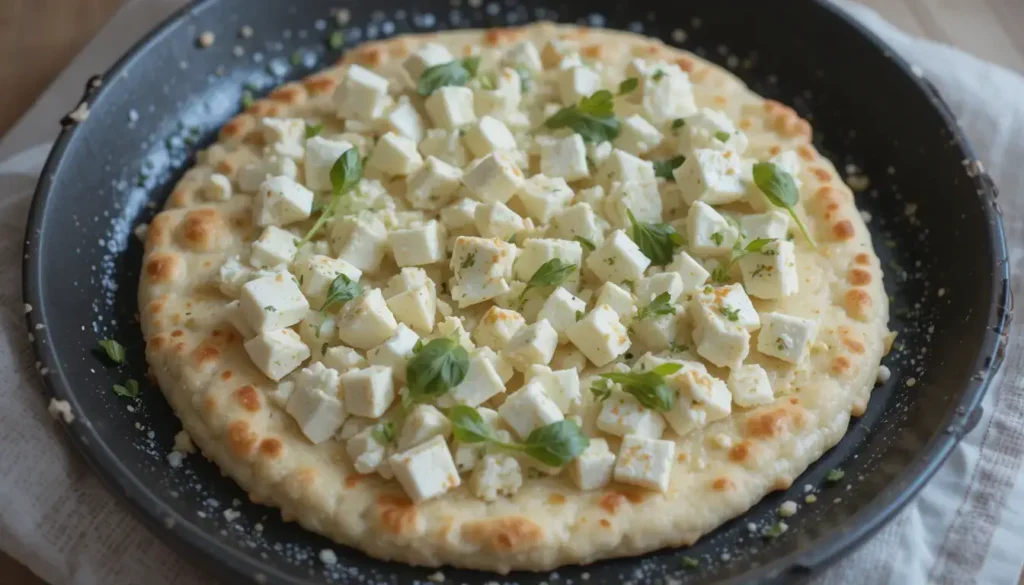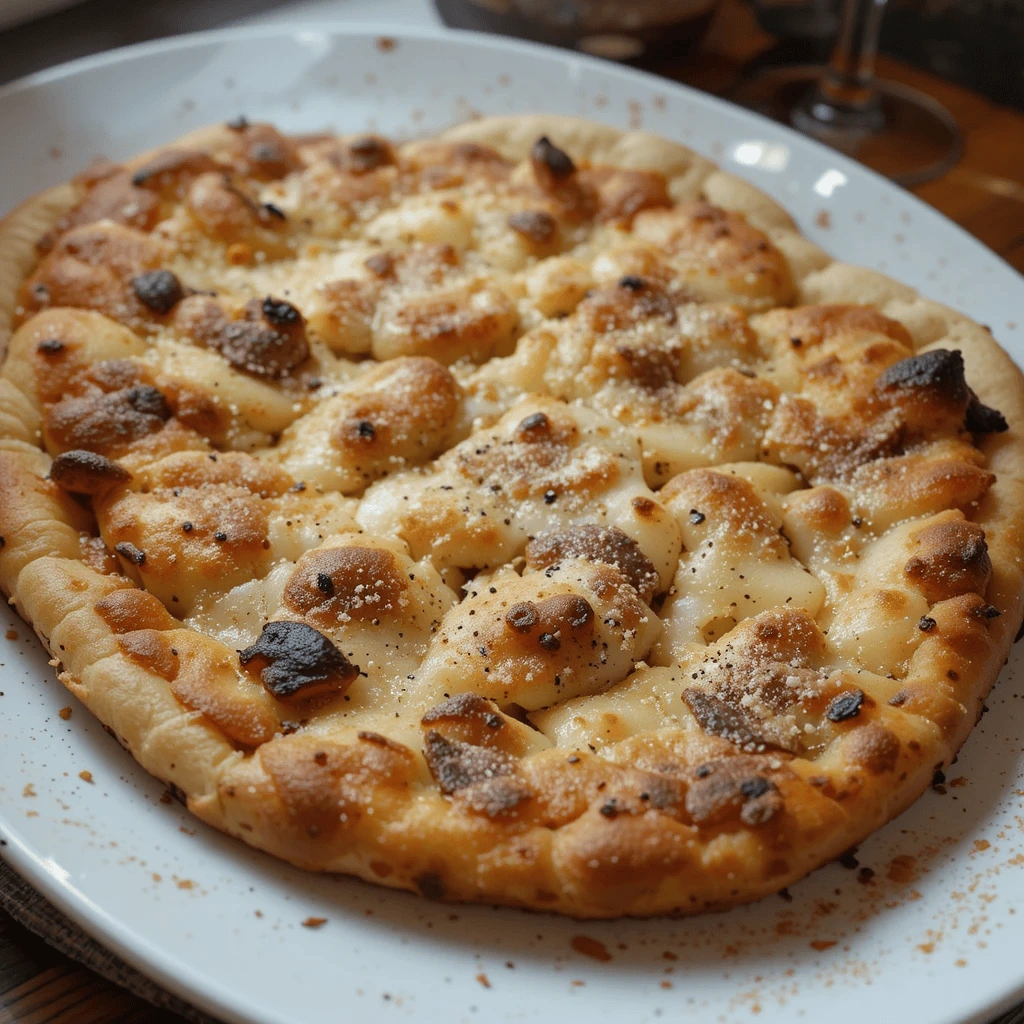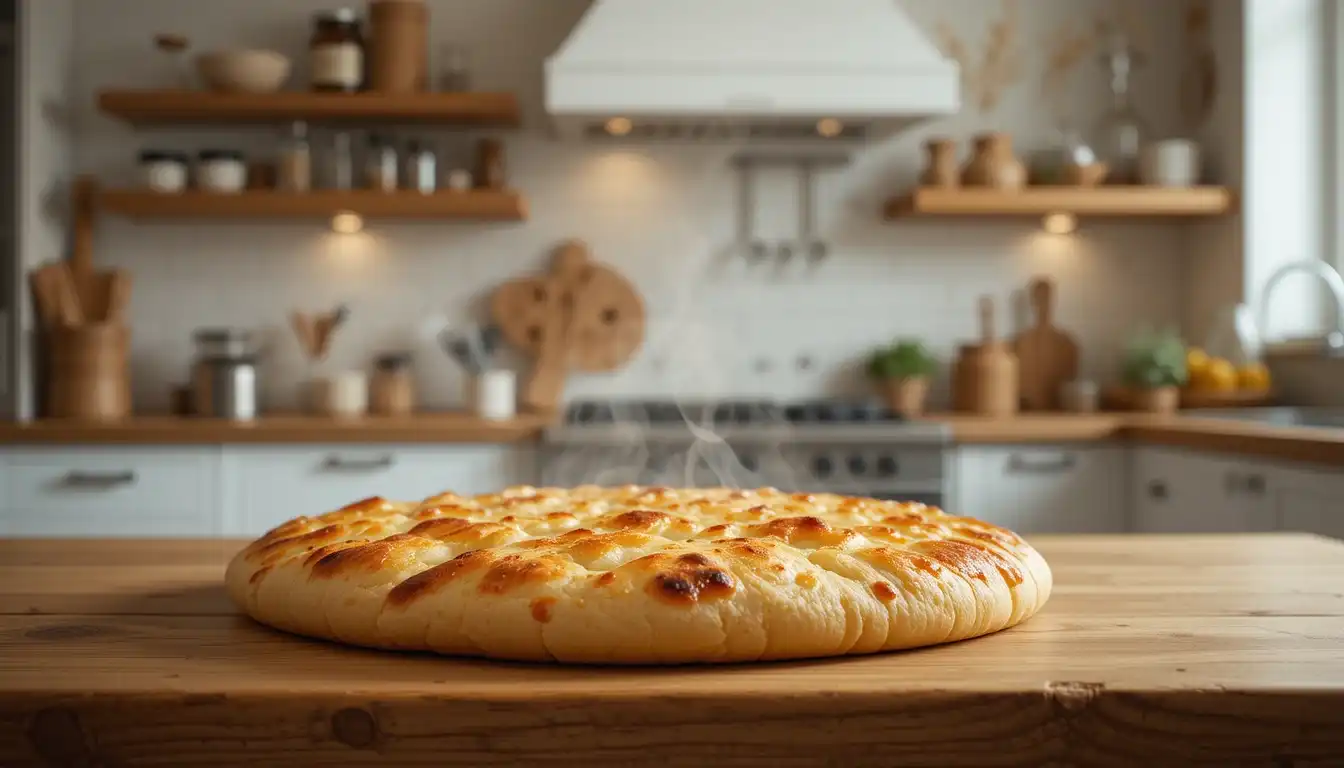Introduction: The Art of Baking Cottage Cheese Flatbread
Baking, at its core, is a beautiful blend of science and a touch of magic, you know? And when you make something as simple yet versatile as a cottage cheese flatbread, you really start to appreciate the process.
Honestly, there is a certain satisfaction that comes with creating something from scratch, something that you can share with loved ones. In addition, this flatbread is a lifesaver on busy weeknights or those times when you need a quick and tasty meal. It’s also incredibly adaptable. For example, I’ve used it as a base for everything from mini pizzas to savory wraps. It’s like a blank canvas for your culinary creativity.
The texture, slightly chewy and slightly crisp, is just something else. However, the big question is how do you know when cottage cheese flatbread is done? It’s such a critical step, as you know.
Furthermore, getting this part right is what separates a perfect flatbread from a soggy or overdone mess. This is where we come in! Basically, this guide is all about ensuring you get that perfect bake every time. So, let’s start this adventure, shall we?
Visual Cues: Spotting When Your Cottage Cheese Flatbread is Done
Okay, let’s talk about what you see when your flatbread is doing its thing in the oven. You know, visual clues are often your first line of defense when baking, and the same is true here. Initially, start by keeping an eye on the color.
A perfectly baked cottage cheese flatbread should transition from a pale doughy appearance to a lovely, light golden brown, especially around the edges. That’s often one of the first signs of done that you’ll notice. Now, this doesn’t mean it should be dark brown or burnt; instead, you want a nice even golden color.
This means that the Maillard reaction is happening, and you will get that gorgeous nutty flavor. Therefore, always check those edges first. If the edges are nicely colored, there is a good chance that the center will be done, too.
Moreover, the overall surface of the flatbread should look cooked, too. It should no longer appear raw or wet looking, but rather dry and set. For example, the surface may start to form little bubbles or have a slightly puffed-up appearance. Also, the flatbread should have a slight sheen, meaning the moisture has cooked out of the dough.
For instance, If you see any raw spots, it’s probably a good idea to give it a little more time in the oven. Don’t be afraid to check on it. Honestly, the oven light will be your friend at this stage. Also, make sure you are checking it frequently. In conclusion, keep an eye out for these color changes and texture shifts. They’re key to getting a perfectly cooked cottage cheese flatbread. This is such an important stage you know.
The Touch Test: Determining Doneness of Your Cottage Cheese Flatbread
Alright, so, visuals are great, but sometimes you just need to get hands-on, right? Therefore, let’s talk about the touch test. In short, the way your flatbread feels can tell you a lot about its doneness. First of all, the flatbread should feel firm to the touch. It shouldn’t be squishy or wobbly. Additionally, a perfectly cooked flatbread should have some resistance when you gently press on it. For example, it should spring back slightly. Honestly, it’s kind of like poking a ripe peach. It shouldn’t be mushy but a little bit firm.
Now, the spring back test is another way to determine doneness. For example, lightly press on the center of the flatbread. If the indentation springs back quickly, it’s a good indication that it’s ready. However, if the indentation remains, or if it feels soft and doughy, it probably needs more baking time. Basically, this test is all about feeling the texture of the flatbread. So, make sure to gently test with your fingers. Also, be careful not to press too hard; you just want to get a sense of the texture.
Therefore, if it’s still doughy in the middle, it needs to go back into the oven for a bit. In summary, the touch test is a crucial step in knowing how do you know when cottage cheese flatbread is done?
Internal Temperature: Using a Thermometer to Check Cottage Cheese Flatbread
Okay, so, visual cues and the touch test are great, but if you really want to be precise, I mean, a food thermometer is the way to go. You know, internal temperature is one of the best indicators of doneness, especially when you are working with bread dough. First, let’s talk about why it’s important. Basically, using a thermometer gives you that extra layer of security. It ensures that the center of your flatbread is fully cooked. Also, undercooked dough can be not only unpleasant, but also unsafe. You see, the goal here is to cook the dough through so that it’s safe to eat.
Now, the recommended internal temperature for a fully baked cottage cheese flatbread is around 200-210°F (93-99°C). However, I usually aim for about 205°F (96°C) for my flatbreads. Therefore, that will get me the texture I want. To use the thermometer, simply insert it into the thickest part of the flatbread. Make sure the tip isn’t touching the bottom of your pan, as that can give you a wrong reading. Also, wait for the temperature reading to steady before pulling the thermometer out. So, if it’s below the target temperature, place it back into the oven. In conclusion, a food thermometer is a great tool to determine if a cottage cheese flatbread is cooked.
Common Pitfalls: Why Your Cottage Cheese Flatbread Isn’t Cooking Properly
Let’s face it, sometimes things don’t go as planned in the kitchen. However, don’t worry! It happens to everyone, even me! Therefore, let’s look at some common problems and what you can do about them. First off, one of the most common problems is soggy cottage cheese flatbread. This is usually because the flatbread hasn’t cooked enough, especially in the middle. In other words, moisture has remained in the dough. Additionally, too much moisture in the batter can also cause this. So, make sure you follow the recipe accurately.
Furthermore, another common issue is underbaked flatbread. If the flatbread is still doughy or gummy, it hasn’t been cooked long enough. For example, increase your baking time slightly and make sure the oven temperature is accurate.
On the other hand, you might end up with overcooked and dry cottage cheese flatbread, which is also not desirable. This could be because the temperature was too high, or you overcooked it. Therefore, always use a timer and reduce the temperature slightly if you think it’s baking too quickly. In summary, knowing these common issues helps you prevent them and make perfectly cooked flatbread every time.
Also, it helps you get closer to answering, how do you know when cottage cheese flatbread is done?
Oven Temperatures: How Oven Heat Affects Your Cottage Cheese Flatbread
Okay, so, let’s dig deeper into the role your oven plays. You know, the oven temperature is one of the most important factors in baking flatbread correctly. First, make sure your oven is properly preheated. This is crucial, because if the oven isn’t hot enough, the flatbread won’t cook evenly or properly. Therefore, a preheated oven ensures that the dough goes directly into the right temperature. In addition, it gives the flatbread the lift it needs.
Now, the ideal oven temperature for baking cottage cheese flatbread is usually around 375-400°F (190-200°C). However, this can vary slightly depending on your oven and recipe. So, I always recommend you test your oven with an oven thermometer to ensure accuracy. Also, your cooking time will vary based on your oven and its performance. Therefore, adjusting the cooking time is key to getting it right. In conclusion, knowing the oven temperature is crucial to baking a flatbread that is perfectly cooked.
Baking Time
Alright, so, we have covered visual cues, touch tests, and oven temperatures. Now, let’s discuss baking time. Basically, time management is key to getting it right in baking. First, general guidelines for cooking flatbread is usually around 15 to 20 minutes. However, it’s important to remember that this can vary based on your oven and the thickness of your dough. Additionally, your baking time may vary if you have added other ingredients into your dough.
Moreover, the thickness of your dough will also influence baking time. For example, a thicker flatbread may need extra time. Therefore, always keep an eye on it. Also, if you added additional ingredients, like veggies, you will probably need additional baking time. You see, I like to check my flatbread around the 15-minute mark, so, if it’s not ready, I continue cooking. In summary, use these guidelines as a starting point, but it’s important to keep a close watch on your flatbread during baking. The goal here is a perfectly baked cottage cheese flatbread.

Troubleshooting: How do you know when cottage cheese flatbread is done? – Solving Common Issues
Sometimes, even when you try your best, things may go wrong. However, don’t panic! So, let’s talk about some common problems and how to solve them. First, let’s discuss what to do if the flatbread browns too quickly. If the top of your flatbread is browning faster than the middle is cooking, you know, your oven may be too hot. Therefore, you may want to reduce the oven temperature slightly. Also, place a piece of foil loosely on top to stop the browning. In addition, another common issue is uneven baking. For example, one part may be fully done while the other part is still doughy. Therefore, rotate your flatbread halfway during baking to promote even heat distribution.
Moreover, if you see any wet or gummy areas in the center, you know, the flatbread may need more time in the oven. In conclusion, with a bit of practice, you can solve any of the above-mentioned issues. However, it’s key to keep an eye on your flatbread, especially during those final few minutes. In summary, knowing how do you know when cottage cheese flatbread is done, requires a bit of trial and error but you got it!
Resting Period: The Importance of Allowing Your Cottage Cheese Flatbread to Set
Alright, so, your flatbread is done cooking, but you know, the process isn’t quite over. Now, let’s talk about the resting period. This is one of the most overlooked but important steps. Basically, once you remove the flatbread from the oven, let it rest for a few minutes. This resting period allows the internal temperature to even out and lets the flatbread firm up. Additionally, it helps in making the texture of the flatbread even better.
Now, I usually recommend resting your flatbread for about 5-10 minutes before you cut it. This will not only help it set, but it also will allow the flatbread to be less likely to break or crumble. Therefore, don’t skip this step. It can make a huge difference. Also, I like to place my flatbread on a wire rack during the resting period to prevent it from getting soggy on the bottom. In conclusion, letting your flatbread rest ensures that it is the perfect consistency and texture. It’s like a final touch to make it ready to eat.
Serving and Storing
Alright, so, now that your flatbread is perfectly cooked and rested, let’s talk about serving and storage. First, how to serve it. You know, the best thing about this flatbread is that it’s so versatile. You can serve it warm with your favorite toppings, or as a side to a soup or salad. For example, I like to cut it into squares and serve them with a drizzle of olive oil and herbs. It can also be used as a base for mini pizzas or as a wrap. Additionally, the options are endless.
Now, what about storage? Basically, once your flatbread is cooled to room temperature, store it in an airtight container in the fridge. It will usually keep fresh for up to 3 days. To reheat, you know, simply place it back in the oven or a pan for a few minutes. Also, you can also freeze it for later. Just be sure to wrap it in plastic wrap and then in foil to avoid freezer burn. In summary, your serving and storage options are wide. Also, it ensures that you are able to enjoy this baked flatbread at its best. In conclusion, it’s so easy to enjoy your perfectly baked flatbread.

Tips and Tricks: To Ensure Your Cottage Cheese Flatbread Is Perfectly Done
Okay, so, let’s recap and also look at a few of my favorite tips and tricks. Basically, these tricks help you make it quicker and easier. First, always, always use parchment paper or a baking sheet. This helps prevent sticking and makes cleanup a breeze. Also, a preheated oven is an absolute must! It ensures the flatbread bakes evenly. In addition, make sure you are measuring your ingredients accurately. Furthermore, a well-prepared dough results in a well-baked flatbread.
Moreover, don’t be afraid to add some herbs or seasonings to the dough. This will not only make it more flavorful, but also make it even more delicious. In addition, a thin layer of oil on the baking sheet will give it a crispy crust. You see, baking is all about the little details that make a huge difference. Therefore, try experimenting with small tweaks. Also, check your flatbread at various stages. In conclusion, by using the above-mentioned tricks and tips, you can be sure of a perfectly cooked flatbread each and every time. Now you are a master baker!
Conclusion
Okay, so, we have reached the end! We have covered quite a bit of ground. Basically, we have talked about visual cues, touch tests, internal temperatures, and troubleshooting tips. You know, mastering the art of baking cottage cheese flatbread takes a bit of practice. However, with these tools, you are well on your way to achieving baking perfection. Therefore, always check for a golden-brown color, a firm spring-back texture, and a safe internal temperature. Additionally, always pay attention to the oven and baking time.
In summary, don’t be afraid to experiment. And most importantly, enjoy the process! Baking is a process of learning. Therefore, every time you bake, it will get easier and better. With these tools and tricks, you can confidently bake perfect cottage cheese flatbread every time. So, go ahead and start baking!
Frequently Asked Questions (FAQs)
Okay, so, let’s tackle some common questions that might be running through your mind.
How do you know when flat bread is done?
Generally, flat bread is done when it turns golden brown. Also, the edges appear cooked and slightly crisp. Moreover, the surface should look dry. In conclusion, a touch test should show that it springs back slightly when pressed.
How do you know when cheese bread is done?
Basically, cheese bread is usually done when the crust is golden brown. Additionally, the cheese is melted and bubbly. In addition, it should also appear firm to the touch. However, you might need to check the internal temperature to make sure it is fully baked.
Why is my cottage cheese flatbread soggy?
Usually, soggy flatbread results from undercooking. Therefore, make sure to cook it for long enough at a higher temperature. Too much moisture in the batter can also make it soggy. Additionally, resting the flatbread after baking on a rack is crucial to make it crisp.
How long to heat flatbread in the oven?
Basically, the baking time for flatbread usually ranges from 15 to 20 minutes at 375-400°F (190-200°C). However, this can change depending on your oven. Therefore, it’s good to keep an eye on it, especially during the last few minutes.

